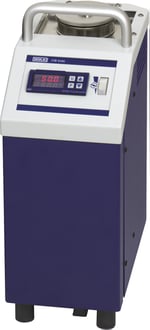Much like any other sensor, temperature sensors need to be calibrated periodically to ensure they are providing accurate and stable readings.
Temperature calibration is commonly done by cycling points within the range of the probe and comparing the results to a reference, or using fixed points such as the triple point of water, defined by the International Temperature Scale of 1990 (ITS-90). The fixed-point method allows labs to measure and verify high accuracy thermometers such as SPRTs against a predefined point.
A temperature calibration can utilize many tools depending on the environment, application and industry. Two of the most common tools that offer a similar function and stability are calibration baths and dry well calibrators. Since both devices can achieve uncertainties in different levels and act as a stable temperature source, deciphering their differences and deciding which one to use comes down to application.
Calibration Baths
For the most uniformity in temperatures, industry experts recommend calibration baths. For calibration, the bath is filled with either water or certain types of oil. Probes are then immersed in the bath, which circulates the liquid to keep it a consistent, desired temperature throughout.
Depending on liquids used and if it’s equipped with temperature controllers that can regulate heating and cooling, users often have multiple baths set to different ranges so sensors can be calibrated to a variety of temperatures.
Calibration baths can be portable or large, stationary lab equipment. They produce some of the lowest calibration uncertainties due to the stable and uniform temperature environment they create. One of the perks of a calibration bath is their ability to calibrate probes of any size or shape, as long as they can be fully submerged. However, a limitation of calibration baths is their environment. Since they expose the device under test to oil or water, sterile environments that don’t allow contaminants in their products cannot use them. In the food industry, if a probe used to measure the temperature of milk was then submerged in oil for calibration, the product could be contaminated.
Dry Wells
Sterile industries depend mostly on dry wells to calibrate their temperature probes. Dry well temperature calibrators can also be portable or stationary for use in a calibration lab. Dry wells (or dry block calibrators as they are often referred) have probe inserts to ensure alignment of the probe with respect to the temperature element inside the block. For calibration, the device under test is inserted into the appropriate slot of the calibration insert. It’s important the probe has a snug fit without more than a few millimeters of extra space as to not allow air currents around the temperature sensor under test. The surrounding air would affect temperature readings and ultimately skew calibration results. Using an internal temperature controller, the dry well either heats or cools to a set temperature in order to test the reading of the probe and perform any necessary calibrations. In the same way calibration baths and the liquids they use are suited for certain temperatures, dry well inserts are also fitted for their application. While most inserts will be brass or aluminum, these do not perform well under high heat. Calibrations involving high heat employ furnace-type dry wells and ceramic inserts that provide a more stable temperature.
Dry wells are often the preferred method of portable calibration because the user doesn’t have to worry about handling liquids. Dry block calibrators also don’t expose temperature probes to other substances that may be harmful to the end product. However, calibrating multiple probes at once can be a challenge if they have bulky gauge heads. This limits the amount of calibrations done at once and requires users to purchase different inserts to fit their probes.
Ultimately, the choice between a calibration bath and a dry well calibrator comes down to the application requirements of temperature range, portability, liquid media handling and temperature stability.
Related Reading:



